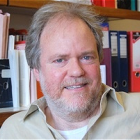Christopher M. Bishop 
Model-Based Machine Learning
The explosive growth of interest in big data and machine learning over the last few years highlights the need for new tools and techniques to accelerate the development of machine learning applications. In this talk I shall give an overview of the model-based approach to machine learning in which a solution is expressed through a compact modelling language, and the corresponding custom machine learning code is generated automatically. The majority of standard techniques correspond to specific choices for the model and arise naturally as special cases, while variants of these techniques to suit specific applications are easily constructed, and alternative related models can readily be compared. Further advantages compared to traditional hand-coding of solutions include transparency of functionality, and the segregation of modelling code from inference code, while newcomers to the field only need to learn the model specification environment in order to gain access to a huge range of machine learning algorithms. The talk will be illustrated with several real-world case studies.
Close abstract
Microsoft Research Cambridge and
University of Edinburgh, United Kingdom
Research Interest: Machine learning, pattern recognition, probabilistic inference, and applications.
Website: Christopher M. Bishop 
Kevin N. Gurney 
Deciding what to do next: Models of action selection in the basal ganglia at multiple levels of description.
How do we decide `what to do next’? How do we choose one action from the multitude of possibilities that the constant barrage of sensory and cognitive information might demand at any one time? I will describe a possible solution to this problem of action selection that implicate the basal ganglia – a set of sub-cortical nuclei – in the role of a central selector or switch, receiving ‘action requests’, and granting behavioural expression to the most salient of these requests. This hypothesis has been used over nearly two decades to direct a programme of work building models of the basal ganglia and associated circuits at several levels of description: from single, conductance-based neurons, through microcircuits and larger scale spiking networks, to rate-coded models of entire brain systems and their embodiment in autonomous robots. I will survey some of this work and, in the process, try to draw out some general methodological principles for working at multiple levels of description in computational neuroscience.
Close abstract
University of Sheffield, Sheffield, United Kingdom
Research Interest: Computational neuroscience at multiple levels of description, focusing on the role of basal ganglia in action selection and action discovery, gaze control and attention.
Website: Kevin N. Gurney 
Barbara Hammer 
Metric learning and model interpretability
Metric learning aims at an automated adaptation of the distance measure which is used for the comparison of data points within a machine learning model. It does not only greatly enhance the capability of popular distance-based classifiers such as k-NN, clustering, or prototype based methods, but it also facilitates model interpretability under the umbrella of so-called relevance learning: the latter refers to the identification of the most popular features and feature correlations for a given task at hand; notable application range from biomedical data analysis up to the industrial process models. Within the talk, we will give an overview about recent results on metric learning for prototype based models. After a presentation of the general principle of metric learning, its theoretical background and applications, we will focus on three recent research directions which are of particular interest for applications:
How to guarantee valid model interpretability in the case of high data dimensionality?
Hoe to link relevance learning to data visualisation?
How to extend metric learning to the domain of structured data?
Close abstract
Bielefeld University, Bielefeld, Germany
Research Interest: Computational intelligence, neural computation, hybrid systems, self-organization, data visualization, bioinformatics, learning theory.
Website: Barbara Hammer 
Yann LeCun 
Deep Learning and the Neural Net Renaissance
The abstract is coming soon.
Close abstract
New York University, New York, United States
Research Interest: Machine learning, computer vision, mobile robotics, and digital libraries.
Website: Yann LeCun 
Jun Tani 
Self-Organization and Compositionality in Cognitive Brains: A Neuro-Robotics Study
The most pressing question about cognitive brains is how they support the compositionality that enables combinatorial manipulations of images, thoughts and actions. When addressing this problem with synthetic modeling, the conventional idea prevalent in artificial intelligence and cognitive science, generally, is to assume hybrid systems and corresponding neural network models, where higher-order cognition is realized by means of symbolic representation and lower sensory-motor processes by analogue processing. However, the crucial problem with such approaches is that the symbols represented at higher order cognitive levels cannot be grounded naturally in sensory-motor reality. The former are defined in a discrete space without any metric and the latter are defined in a continuous space with a physical metric. These, therefore, cannot directly interact with each other, regardless of the interface that is assigned between them. My proposal in this talk is to reconstruct higher-order cognition by means of continuous neuro-dynamic systems that can elaborate delicate interactions with the sensory-motor level while sharing the same metric space. Our neuro-robotics experiments – including language-action associations and the learning of goal-directed actions – show that the compositionality necessary for higher-order cognitive tasks can be acquired by means of self-organizing dynamic structures, via interactive learning between the top-down intentional process of acting on the physical world and the bottom-up recognition of perceptual reality. The analyses on these robotics experiments suggest that nonlinear dynamic phenomena, such as bifurcations and the chaotic dynamics induced by unstable fixed points, could play essential roles in realizing higher-order functions.
Close abstract
Korea Advanced Institute of Science and Technology, Daejeon, Republic of Korea
Research Interest: Humanoid robots, cognitive neuroscience, nonlinear dynamics, psychology, and phenomenology.
Website: Jun Tani 
Paul F.M.J. Verschure 
From Reflex to Goals: The Distributed Adaptive Control Theory of Mind, Brain and Behaviour
I will address the question what the function is of the brain and how this function is realized. The brain evolved to maintain a dynamic equilibrium between an organism and its environment through action. The fundamental question that such a brain has to solve in order to deal with the how of action in a physical world is: why (motivation), what (objects), where (space), when (time) or the H4W problem. Post the Cambrian explosion of about 560M years ago, a last factor became of great importance for survival: the who of other agents and now brains adapted to the H5W challenge. I propose that H5W defines the top-level objectives of the brain and will argue that brain and body evolved to provide specific solutions to it by relying on a layered control architecture that is captured in the Distributed Adaptive Control (DAC) theory of mind and brain I have proposed and elaborated with my colleagues. I will show how H5W can be solved through interactions across multiple layers of neuronal organization, suggesting a very specific organization along the neuraxis. In explaining how the function of the brain is realized I will show how the DAC theory provides for very specific predictions that have been validated at the level of behaviour and the neuronal substrate. I will in particular look at episodic memory, decision-making and the generation of goal-oriented behaviour. Examples will be taken from work on animals, humans and robots.
Close abstract
Catalan Institut for Advanced Research Studies and Universitat Pompeu Fabra, Barcelona, Spain
Research Interest: Biologically constrained models of perception, learning, behavior, and problem solving that are applied to wheeled and flying robots, interactive spaces and avatars.
Website: Paul F.M.J. Verschure 

![]()









